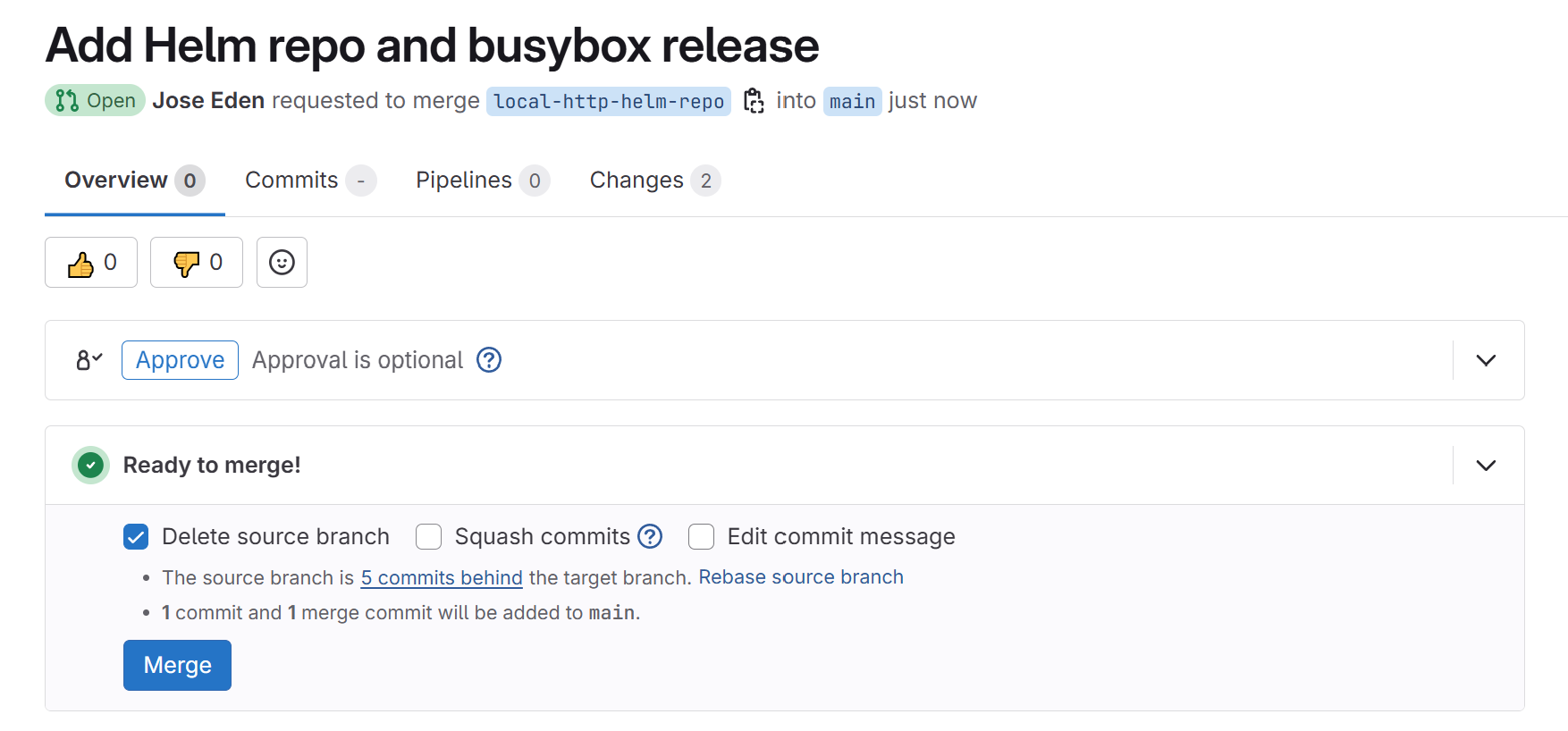HTTP Repositories
Overview
This guide shows how to connect FluxCD to a Helm chart repository hosted over HTTP.
For simplicity, we'll be using the private repository ChartMuseum (from previous lab) as the HTTP Helm repository.
A few notes:
- I'm running the lab in a Windows 10 machine
- Tools used: Docker Desktop, WSL2
- A Kubernetes cluster is using
kind - Flux is running inside the Kubernetes cluster
- Gitlab is used for the Git repositories
Flux connecting to the HTTP repository:
- The private repository is deployed as a container in the same Windows machine
- For user to connect to the private repository via HTTP, use the
127.0.0.1:8080 - For Flux to connect to the private repository via HTTP, use the
host.docker.internal:8080
Pre-requisites
Project Directory
Make sure to go through the pre-requisites before proceeding to the next steps
If you followed the steps in setting up Flux, your project directory should have the following files:
$ tree
.
├── README.md
└── charts
└── clusters
└── dev
└── flux-system
├── gotk-components.yaml
├── gotk-sync.yaml
├── kustomization.yaml
3 directories, 6 files
To organize the manifests, we will create folders for each lab, along with their respective kustomization.yaml file.
For this lab, create the helm-repos-http directory:
mkdir clusters/dev/helm-repos-http
Create the Helm Repository
Make sure ChartMuseum is deployed and listening on port 8080 before proceeding with the steps below.
Start by defining the Helm repository resource in your cluster directory.
In the cluster folder, create a new YAML file for the HelmRepository
# clusters/dev/helm-repos-http/localhttprepo.yaml
---
apiVersion: source.toolkit.fluxcd.io/v1beta2
kind: HelmRepository
metadata:
name: local-http-repo
namespace: default
spec:
interval: 5m0s
url: http://host.docker.internal:8080 ## this is the ChartMuseum address
secretRef:
name: local-http-repo-secret
---
apiVersion: v1
kind: Secret
metadata:
name: local-http-repo-secret
namespace: default
stringData:
username: chartuser
password: ***********
This tells FluxCD to pull charts from the HTTP Helm repo every 5 minutes.
Create Helm Release Resource
Now define the HelmRelease that will use the repository.
# clusters/dev/helm-repos-http/busybox-helm-release.yaml
apiVersion: helm.toolkit.fluxcd.io/v2beta1
kind: HelmRelease
metadata:
name: helmrelease-busybox
namespace: default
spec:
interval: 1m
chart:
spec:
chart: busybox ## Chart name and version
version: 0.1.0
interval: 1m
sourceRef:
kind: HelmRepository
name: local-http-repo ## Created in the previous step
namespace: default
This will deploy the busybox chart from the defined repo every 1 minute.
Add to kustomization
Add the files to the kustomization.yaml to ensre Flux watch for the changes:
apiVersion: kustomize.config.k8s.io/v1beta1
kind: Kustomization
resources:
- gotk-components.yaml
- gotk-sync.yaml
- podinfo-repo.yaml
- podinfo-customization.yaml
- nginx-helm-release.yaml
- busybox-helm-release.yaml
- localhttprepo.yaml
Commit and Push the Changes
After writing the YAML, commit and push it to your Git repository.
## Make sure main branch is updated
git checkout main
git pull
## Create the new branck then push
git checkout -b local-http-helm-repo
git add .
git commit -m "Add Helm repo and busybox release"
git push origin local-http-helm-repo
After pushing, merge the changes to the main branch. Since we are using Gitlab in this setup, login to the Gitlab UI and go to the repository. We should see a Create merge request at the top. Click it and provide a title and description to the merge request in the next step.

In a typical team setting, developers create merge requests which are then reviewed and approved by other team members. For this lab, you can go ahead and click Approve and Merge directly.

Trigger Reconciliation
Once changes are merged, tell FluxCD to sync the state.
flux reconcile kustomization flux-system --with-source
Verify deployment:
$ kubectl get helmrelease
NAME AGE READY STATUS
helmrelease-busybox 8m True Helm install succeeded for release default/helmrelease-busybox.v1 with chart busybox@0.1.0
$ kubectl get helmrepo
NAME URL AGE READY STATUS
local-http-repo http://host.docker.internal:8080 8m5s True stored artifact: revision 'sha256:be893c02c34a98008a65f26812c0492525896cc686e3946e58637cc026451211'
$ kubectl get po
NAME READY STATUS RESTARTS AGE
helmrelease-busybox-64cbf9fb98-xhh7g 1/1 Running 0 87s
Troubleshooting
To check if the Helm repository is created:
$ flux get sources helm -A
NAMESPACE NAME REVISION SUSPENDED READY MESSAGE
default local-http-repo sha256:a1af7d4c False True stored artifact: revision 'sha256:a1af7d4c'
If you're running the test locally inside a Windows machine, you may need to se the url for the ChartMuseum address to:
apiVersion: source.toolkit.fluxcd.io/v1beta2
kind: HelmRepository
metadata:
name: local-http-repo
namespace: default
spec:
interval: 5m0s
url: http://host.docker.internal:8080 ## this is the ChartMuseum address
secretRef:
name: local-http-repo-secret
For other errors, please see General Troubleshooting.